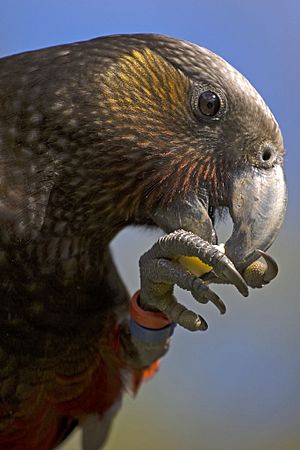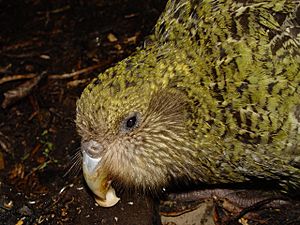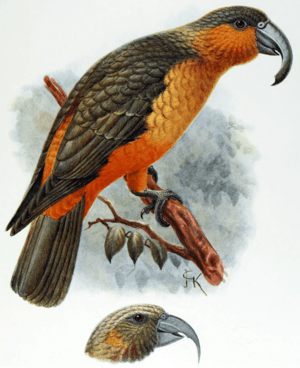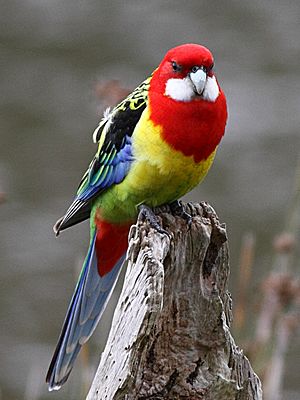Parrots of New Zealand facts for kids
New Zealand is a special place because it was once very isolated. This meant there were no natural mammal predators like cats or stoats. Because of this, parrots in New Zealand evolved in unique ways! Some, like the kakapo, learned to live on the ground. Others, like the kea, adapted to cold mountain areas. Many more lived in the forests.
However, things changed when people arrived. First the Māori, and later European settlers, brought new animals. These animals, like rats and possums, hunted the parrots. People also cut down forests, destroying parrot homes. Sadly, this has caused many parrot numbers to drop. Today, the kakapo is almost gone, and three other parrot species are in danger.
Some parrots from Australia have also come to New Zealand. They were either released on purpose or escaped by accident. Now, some of these Australian parrots have made New Zealand their new home.
Contents
New Zealand's Unique Parrots
Most parrots found naturally in New Zealand are endemic. This means they are found nowhere else in the world! Sometimes, a bird from Australia might fly over, but generally, New Zealand's parrots are truly unique. There are eight types of parrots that are native to New Zealand and still alive today.
Main Island Parrots
The main islands of New Zealand are home to several special parrots:
- The kea (Nestor notabilis) is a very smart parrot that lives in the mountains.
- The New Zealand kaka (Nestor meridionalis) is a forest parrot.
- The kakapo (Strigops habroptilus) is the world's only flightless parrot. It's also the heaviest parrot!
- There are three types of kakariki, which are smaller, colourful parakeets:
- The yellow-crowned parakeet (Cyanoramphus auriceps)
- The red-crowned parakeet (Cyanoramphus novaezelandiae)
- The orange-fronted parakeet (Cyanoramphus malherbi)
Island Parrots
Other unique parrots live on New Zealand's smaller islands:
- The Chatham parakeet (Cyanoramphus forbesi) lives on the Chatham Islands.
- The Antipodes parakeet (Cyanoramphus unicolor) and Reischek's parakeet (Cyanoramphus hochstetteri) live on Antipodes Island.
Parrot Conservation Status
Many of New Zealand's native parrots are in trouble.
- The total number of kakapo is very small. In 2012, there were only 126 kakapo left. Scientists are working hard to save them.
- The orange-fronted parakeet is critically endangered. This means it's very close to extinction.
- The kaka is listed as endangered.
- The kea is considered vulnerable.
Parrots That Are No Longer Here
Sadly, some New Zealand parrots have already disappeared forever.
- An unknown parakeet used to live on Campbell Island. It died out before scientists could even describe it.
- The Chatham kaka (Nestor chathamensis) from the Chatham Islands became extinct a long time ago. We only know about it from old bones found in the ground.
- The Norfolk kaka (Nestor productus) from Norfolk Island also died out by 1851.
Parrots from Other Countries
Some parrot species from Australia have made their way to New Zealand. This happened either because people brought them here on purpose or they escaped from cages. Only two types of these introduced parrots have large, stable populations in the wild. These are the eastern rosella and the sulphur-crested cockatoo. You might also see small numbers of Crimson rosellas and Galahs.
Eastern Rosella
The eastern rosella (Platycercus eximius) is a colourful parrot. You can find them in the northern part of the North Island, around Wellington, and near Dunedin. It's believed that the Dunedin population started around 1910. Some birds were released into the sea after customs refused to let them into the country. The Auckland population began around 1920, and the Wellington one around 1960. By 1928, rosellas were already causing problems around Auckland.
Sulphur-crested Cockatoo
The sulphur-crested cockatoo (Cacatua galerita) is a large, white parrot with a yellow crest. These birds are thought to have escaped from people's homes. Their wild population in New Zealand is still less than 1000 birds. The first wild cockatoos were seen in the Waitākere Ranges in the early 1900s. Today, you can find them in the Auckland Region, western Waikato, the Turakina–Rangitikei area, the Wellington Region, and Banks Peninsula.
Protecting Native Birds
Around 1992, someone tried to start a wild population of rainbow lorikeets near Auckland. However, these birds were seen as a threat. They could compete with native birds for food and homes. They might also damage fruit crops. So, in 1999, the rainbow lorikeet was declared an 'unwanted organism' under the Biosecurity Act. A plan was made to remove the estimated 200 wild birds. Traps were used to catch them. This program is still ongoing to make sure these lorikeets do not create a lasting wild population. This helps protect New Zealand's unique native parrots.





